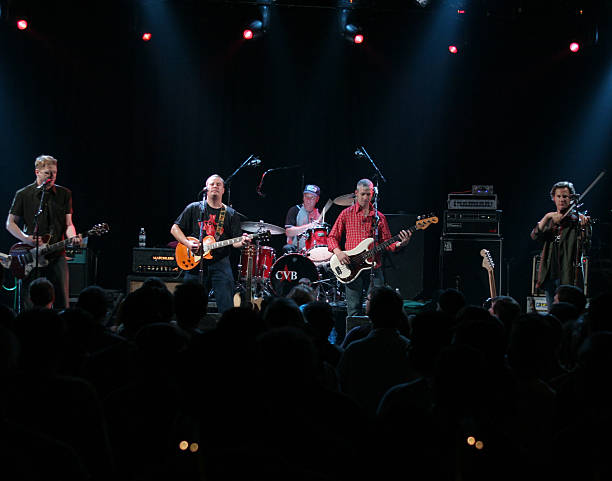“Pictures of Matchstick Men” by Camper Van Beethoven was not the biggest modern rock hit of 1989, but it was one of the most significant. College rock was becoming something else as the decade drew to a close: it would be two years before it was clear what that new thing was, when Nirvana’s “Smells Like Teen Spirit” knocked Michael Jackson off the charts and everyone started wearing flannel shirts. But 1989 signals the pivotal moment when the relatively cozy, intimate world of college radio began morphing into the louder, flashier world of alternative rock, and while one could pick any number of that year’s landmark releases to signify this change — Nirvana’s first album Bleach, the Pixies’ Doolittle, Mother’s Milk by the Red Hot Chili Peppers — Key Lime Pie, Camper Van Beethoven’s final studio LP before a decade-plus hiatus, merits strong consideration.
Camper Van Beethoven straddled two eras. The group belonged to the second wave of college rock pioneers, coming into its own as first-wavers like Hüsker Dü and the Replacements started bottoming out, while others like R.E.M. ascended into the “real” world of radio hits and MTV. Initially formed in 1983 in Redlands, Calif. by guitarists David Lowery and Chris Molla, then reformed a year later out of local bands in and around UC Santa Cruz, Camper Van Beethoven never really had a consistent membership. What most fans consider the classic lineup consisted of Lowery on guitar and lead vocals, bassist Victor Krummenacher, violinist/multi-instrumentalist Jonathan Segel, guitarist Greg Lisher and drummer Chris Pedersen. The band’s odd blend of styles — hardcore played with a country twang, weird approximations of Russian folk tunes, ska-influenced spaghetti western instrumentals — struck a chord with college radio listeners, especially as Camper seemed to deliver it all with tongue firmly in cheek.

“In 1985 and 1986, underground rock music was a very serious business to most of our friends and peers,” Lowery later wrote. “Lyrics were serious. The music was serious. Everything was very important and burdened with meaning… We felt it our mission to be seriously unearnest.”
Camper Van Beethoven became stars of the underground culture by making fun of that culture with songs like “Take the Skinheads Bowling” and “Where the Hell Is Bill?” Those early records had a deceptively tossed-off quality, a wandering eclecticism that embraced accident and was happy — indeed, eager — to go off on musical tangents. This willingness to experiment was picked up by later artists like Pavement, Smog and Beck, who took CVB’s casual aesthetic and ran with it to indie rock stardom.
That said, Camper’s discography is marked by a steady “improvement” in sound. Their debut album Telephone Free Landslide Victory, released on tiny Independent Project Records in June 1985, was self-produced on a shoestring budget, while Key Lime Pie was a major label affair, recorded in Hollywood by Dennis Herring, who first worked with the band on 1987’s Our Beloved Revolutionary Sweetheart and would go on to produce Throwing Muses, Counting Crows and Modest Mouse, among others.

Key Lime Pie was not only Camper Van Beethoven’s most technically professional-sounding album: it was also the last one before Krummenacher, Lisher, and Pedersen quit the group in 1990 while on tour in Sweden. But even though it features relatively slick production, Key Lime Pie is still a weird record. Any mission to be “seriously unearnest” had been aborted by that time: Lowery’s lyrics were dark and often despairing, drawing inspiration from the end of a relationship and the tensions within the band itself. When executives at Virgin Records heard the initial cut of Key Lime Pie, they — as the music business saying goes — ”didn’t hear a single.” During the demo sessions for Revolutionary Sweetheart, Camper Van Beethoven had recorded a cover of an old Status Quo song, “Pictures of Matchstick Men” (an outtake that eventually surfaced on the 2004 CD reissue of the band’s self-titled third album), and Virgin insisted they re-record the song for Key Lime Pie and release it as the first single. Helped by the success of a fancy MTV video, the record became a hit, eventually reaching number one on Billboard’s Modern Rock Chart.
“Picture of Matchstick Men” had already been a winner for Status Quo and its author Francis Rossi, the group’s singer and lead guitarist. It was their debut single and entered the U.K. and U.S. charts in late 1967, alongside other future Nuggets-caliber psychedelic curios as the Move’s “I Can Hear the Grass Grow” and the Idle Race’s “Imposters of Life’s Magazine.” Though it features some of that era’s sonic affectations (the phasing wah-wah guitar added to the verses in the single’s mono mix, for instance), “Pictures of Matchstick Men” has a muscular rock core that hinted at the kind of music Status Quo would eventually settle into: the band pretty much disappeared from American pop music consciousness after “Matchstick Men,” but found massive and enduring success overseas by dropping its psychedelic finery, changing into old jeans, and cranking out record after record of boogie-fied rock and roll.

At first listen, the song’s central image seems like typical LSD-inspired surrealism, but its origin is more earthbound. “Matchstick men” is how some critics described the human figures in the paintings of 20th century British artist L.S. Lowry. Working in a style that today might be called folk art, Lowry painted hundreds of industrial scenes from his native Manchester and its environs, in which crowds of “matchstick men” (Americans would say “stick figures”) scurry around vast Victorian-era factories and bleak Northern fields. The song’s subject matter is equally prosaic (appropriately so, as Rossi famously wrote “Pictures of Matchstick Men” while hiding out in his bathroom, trying to avoid a visit from his mother-in-law). Though the psychedelic vibe of the lyrics invites all sorts of cosmic interpretations, in the end, “Pictures of Matchstick Men” is about a classic pop song scenario: the singer’s been dumped by his girlfriend, and he still sees her face everywhere he looks.
The yearning implicit in this story is made aurally explicit in Camper’s cover, which takes the original’s hypnotic riff away from the guitar and gives it to the solo violin, played by new member Morgan Fichter (original violinist Segel either quit the band or was fired during rehearsals for Key Lime Pie). The effect is closer to an Appalachian ballad than a Summer of Love pop ditty — a high and lonesome sound, the kind of tune Dock Boggs would have recorded in the 1920s. (CVB was already familiar with Boggs’ type of music, having covered the old folk song “Oh Death” on Our Beloved Revolutionary Sweetheart.)

That hillbilly solitude is shattered when the rest of the band enters on the fifth measure. Though the violin continues throughout, and reaches a Velvets-esque drone by the end, the rest of the band is playing crispy modern rock. The arrangement not only avoids psychedelic pastiche, but also most of the ramshackle whimsy that was once Camper Van Beethoven’s trademark. The original Status Quo single had a slightly shuffled four-four, showing the influence of players like Ringo Starr and Mitch Mitchell. Chris Pedersen’s drum track slows the song down by about 12 bpm, and has an almost machine-like precision. Krummenacher bounces around on bass, but never really launches into space, and Lisher and Lowery keep to simple rhythm guitar parts. “Matchstick Men” brings to mind mid-tempo hits that were still a few years in the future, like the Cranberries’ “Zombie,” Coldplay’s “Yellow,” or nine-tenths of Oasis’ output. More directly, it anticipates “Low,” the 1993 hit for David Lowery’s post-Camper band Cracker. “Low” has virtually the same bass line and drum pattern as “Matchstick Men,” but takes the big drum and guitar sound even further.
The college rock audience experienced the commercial success of alternative rock as a vindication of its musical taste, a triumph of “good” music over major label crap. A common cliché was that Nirvana came in and destroyed all the hair metal bands that were dominating rock radio at the time. But in retrospect, it seems like more of a capitulation than a conquest. Sure, the fishnets, glam make-up and hairspray went away (though, on balance, the hair itself probably got longer). But sonically, indie rock started becoming as processed and formulaic as any record by Whitesnake or Skid Row. (Kurt Cobain eventually started railing against the production sheen of Nirvana’s breakthrough Nevermind: “I’m embarrassed by it now,” he told music journalist Michael Azerrad. “It’s closer to a Mötley Crüe record than it is a punk rock record.”) In this light, “Pictures of Matchstick Men” could be seen as one of the early signs of surrender.

But even seen in this light, “Picture of Matchstick Men” remains a great single, and the song (both Camper’s version and Status Quo’s original) has stuck around, showing up on everything from BBC soccer documentaries to Men in Black III. It’s been covered by punk-garage band Slickee Boys, goth-metal heroes Type O Negative (with Ozzy Osbourne on vocals) and Brit rave rockers Kasabian, among others. Both Status Quo and the CVB/Cracker collective still feature the song in their live sets, which gives it the rare quality of being a classic of both Sixties psychedelia and Nineties alternative rock.
And if Lowery’s attempts with Cracker to develop the “Matchstick Men” sound into a reliable hit-making formula didn’t ultimately pay off, neither did alternative rock’s half-hearted grab at the pop culture crown. By the late Nineties, it was clear that the real winners in the pop music marketplace were hip-hop and dance-pop, both of which evolved in incredible ways while guitar-based rock tried to sort itself out.
Artistically speaking, the failure to become rock icons was probably a blessing for the members of Camper Van Beethoven, freeing them from major-label pressure to succeed, and allowing them to pursue the weird exploratory music that is their forte. They all flourished with non-Camper projects like Cracker, Monks of Doom (featuring Krummenacher, Lisher, Pedersen and sometimes-Camper guitarist David Immerglück) and the Third Mind. Improbably, they even started to work together again, reuniting in 1999 to put together some archival Camper Van Beethoven releases (including a cover of Fleetwood Mac’s album Tusk in its entirety), and eventually recording several albums of new Camper material. Today, CBV resembles nothing so much as a semi-dysfunctional extended family, with the same tensions but tempered by a middle-aged tolerance of each other’s foibles. Maybe that’s what makes them the ultimate Gen-X band.
Pictures of Matchstick Men (KORD-0083)






